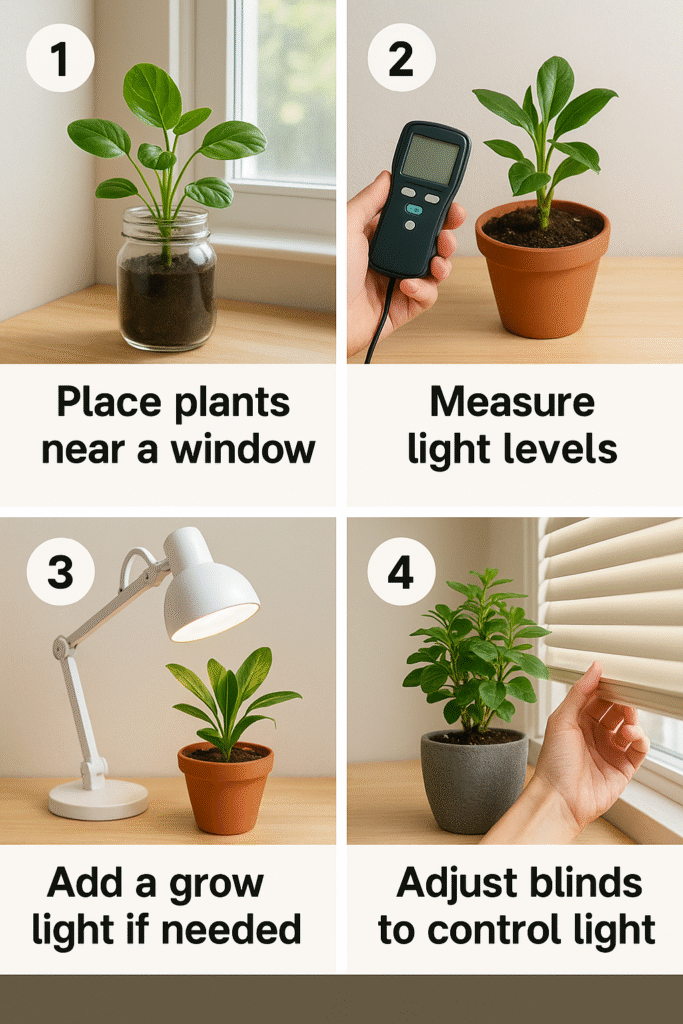One of the most important—yet often overlooked—elements of plant care is lighting. Whether you’re growing herbs on a windowsill or decorating your home with tropical foliage, understanding the right light for your plants is key to helping them thrive. This guide breaks down light types, how to assess your space, and how to match the right plant to the right light.
Why Light Matters for Plants
Light powers photosynthesis, the process plants use to produce food. Without enough light, your plant’s growth will slow, its leaves may turn yellow, and flowering or fruiting may stop altogether. On the other hand, too much direct light can cause leaf burn or drying.
Getting the right light for your plants is essential for strong roots, vibrant foliage, and healthy development.
Types of Light: Know the Differences
☀️ Direct Sunlight
- Full-strength sun rays that fall directly on the plant
- Common near south-facing windows
Best for: Cacti, succulents, rosemary, aloe vera
🌤️ Bright Indirect Light
- Sunlight filtered through a curtain or reflected off surfaces
- Common near east- or west-facing windows
Best for: Peace lily, pothos, monstera, snake plant
🌥️ Low Light
- Shaded areas with little to no natural light
- Often found in north-facing rooms or far from windows
Best for: ZZ plant, cast iron plant, some ferns
How to Measure Light in Your Home
1. Observe Natural Light Patterns
- Check which windows receive morning, midday, or afternoon sun
- Note where shadows fall and how long light lasts
2. Use the Hand Shadow Test
- Place your hand under the light where your plant will go
- Sharp shadow = bright light
- Soft shadow = indirect light
- No shadow = low light
3. Use a Light Meter or App
- For precision, use a smartphone light meter to measure in foot-candles or lux
Matching Plants to Light Levels
| Light Level | Plant Examples |
|---|---|
| Direct Sunlight | Succulents, cacti, citrus, lavender |
| Bright Indirect Light | Monstera, peace lily, spider plant, fiddle leaf fig |
| Low Light | Snake plant, pothos, ZZ plant, cast iron plant |

Tips to Improve Indoor Lighting
- Rotate plants weekly to encourage even growth
- Use mirrors or white walls to reflect light
- Supplement with grow lights if natural light is insufficient
- Avoid placing light-sensitive plants too close to windows
Grow Lights: When and How to Use Them
If your home doesn’t provide enough light, especially in winter or shaded apartments, artificial lights can help.
Types of grow lights:
- LED full-spectrum bulbs (energy-efficient and cool to the touch)
- Fluorescent tubes (great for herbs and seedlings)
Usage tips:
- Keep lights 6–12 inches above plants
- Use a timer to mimic natural daylight (12–16 hours/day)
Want more beginner-friendly advice? Don’t miss our guide on Low-Maintenance Plants Perfect for Beginners.
Final Thoughts
Understanding the right light for your plants is one of the best things you can do for their long-term health and beauty. By assessing your space and matching each plant to the light it needs, you’ll enjoy lush, vibrant greenery all year round.
You can buy indoor grow lights and light meters to support plant growth here on Amazon.
